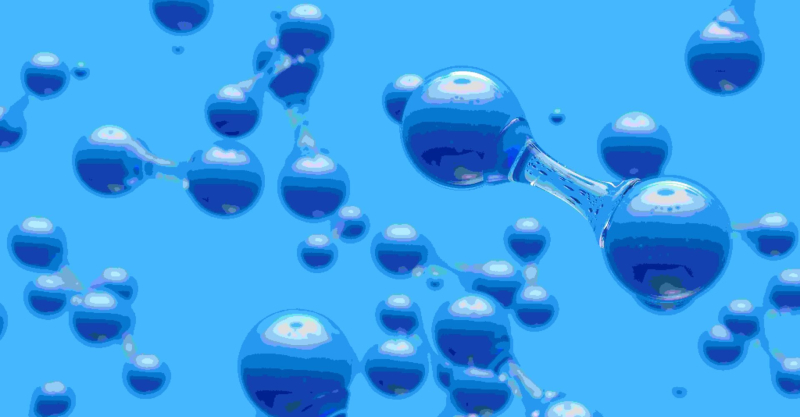
© Rafael Classen/rcphotostock.com
In the immense global quest to find energy that is cleaner and more sustainable than fossil fuels, hydrogen now occupies a central place. Whether in its geological form (white or native hydrogen) or by electrolysis of water (green hydrogen), it is considered in certain respects as the oil of tomorrow. The production of green hydrogen is today faced with numerous obstacles, particularly in terms of costs and environmental impacts . Two main obstacles which slow down its large-scale production. However, a recent discovery, shared in an article in Nature Materials, could change this observation positively, at least in terms of operational costs.
L’green hydrogen, a truly clean gas ?
If we often talk about hydrogen as a clean energy vector, the reality is much more nuanced. According to this article from Reporterre, “more than 95 % of the hydrogen produced in the world comes from methane, oil or coal, through very polluting processes, particularly in terms of greenhouse gas emissions“. As for clean energy, we have seen better.
Green hydrogen would therefore be a possible solution. This is produced using electrolysis, a process that breaks down water into oxygen and hydrogen using an electric current. If we nickname it vert, it is because the electricity necessary for the electrolysis reaction comes from renewable sources.
The problem is that the renewable sources in question (wind farms or solar farms for example) also have an undeniable environmental impact. To produce energy in this way, you need space, a lot of space. These installations therefore require immense areas to operate correctly, and consequently cut back on agricultural land.
L’electrolysis itself does not’ is not perfect and the electrolyzers necessary for the process are very demanding in metals and may involve the use of toxic substances.
Add to this the manufacturing of components necessary for these infrastructures which is not really ecological (steel, cobalt, lithium or carbon) and it is easy to realize that green hydrogen loses a little his color. Worse still, MEPs voted in 2022 for an amendment allowing manufacturers to attach the word green to hydrogen produced from gas or coal. L’green hydrogen therefore looks gray.
A promising technical development
If the report published in Nature Materials does not settle not the issue of environmental impact, it highlights a discovery that could make hydrogen cheaper to produce.< /p>
This innovation comes from the Technion-Israel Institute of Technology and departs from the traditional design of electrolyzers. In a classic device, a membrane prevents hydrogen and oxygen from mixing, because they can explode when they meet. However, these membranes are very expensive to replace and represent a good part of the operating cost of these machines.
Instead of a membrane, the researchers managed to produce hydrogen by producing hydrogen and oxygen in two chambers distinct. An innovative approach, which could considerably reduce production costs.
Another advantage of this design: its ability to operate with variable amounts of electricity. Very useful when we know the intermittent nature of solar or wind energy sources.
Challenges and potential of this new method
Even if it is promising, this approach is not yet perfect. Mark Symes, a chemist at the University of Glasgow, has indeed noted a significant drawback. During the electrolysis process, water is separated into oxygen and hydrogen using two electrodes: a cathode (where the reduction occurs) and an anode (where the reaction occurs). oxidation). Here, it's the anode that poses a problem.
Indeed, bromate (an ion involved in the electrolysis process) has the unfortunate tendency to react to the anode prematurely. If this happens, electrolysis is disrupted, as well as the production of oxygen and hydrogen.< /p>
To avoid this reaction, the researchers behind this new technique had to develop a special coating for the anode, preventing the bromate to react with it and which allows the hydrogen to escape to collect it without it being contaminated.
The concern is that this particular coating requires the use of hexavalent chromium, a very toxic compound, classified in the CMR~60 category ~/strong> (carcinogenic, mutagenic and reprotoxic). If it were to leak, the process would then be completely compromised from an environmental and health point of view.
Another drawback, the electrodes of this new system uses ruthenium and platinum, two relatively rare and expensive metals. The team of researchers is already working to develop a new device to limit these two problems.
Producing l& #8217;green hydrogen without membrane is perhaps one of the elements of response to make this mode of production more viable in the long term. On the other hand, it will not be the wave of a magic wand that will allow total decarbonization of electrolysis. However, the previously mentioned inconveniences will have to be resolved before this new type of device can be adopted. However, this will not resolve the main pitfall of green hydrogen: the source of the energy necessary to manufacture it and its environmental impact.
- In theory, the hydrogen produced by electrolysis comes from renewable energy sources, but the reality is more complex.
- Researchers from the Technion-Israel Institute of Technology have developed a new, more economical electrolysis technique.
- This is not yet perfect and would require some optimizations to be completely reliable.
📍 To not miss any news from Presse-citron, follow us on Google News and WhatsApp.
[ ]

